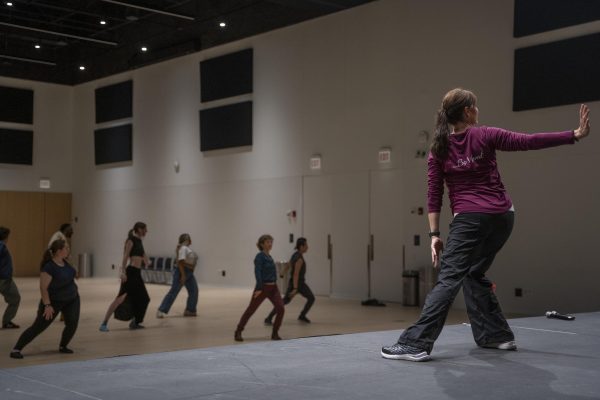Columbia’s first lady returns to her first love
November 16, 1998
Life can be full of irony. Just as Columbia’s President John B. Duff decides to retire from professional life, his wife, Ms. Estelle M. Shanley, decides to return to the field of her first success, journalism.
Shanley is currently a public relations consultant. Her clients include WH Smith, Lifelink and the Chicago Board of Realtors. While Shanley has found much financial success in public relations work, it is journalism that truly fulfilled her spirit.
Shanley left the field of journalism after 19 years of reporting. She said, “I never should have left. It is the biggest regret of my life. I need the rhythm and satisfaction back in my life.”
While Shanley said the money in public relations work is phenomenally larger compared to journalism, she proclaimed, “I need to work in a field that gives me inner peace. I need to feel I am making a contribution to the world.”
Shanley began her career in journalism in the ‘60s, a time when working women were not seen in a positive light. Shanley said a woman’s main roles was to raise children and keep her husband happy. Shanley felt, although she loved being a mother and wife, there was something missing from her life. She said, “I thought there was something wrong with me until I read Betty Friedan’s book The Feminine Mystique. Everything she wrote, I felt. It became my beginning and I knew it was okay to want my own identity.”
Shanley began freelancing for three or four newspapers in the ‘70s. She learned how to discipline herself to write while raising her three daughters. She said, “I learned how to write a story with a sick baby across my lap.” Her literary skills, which Shanley believes comes from her Irish genes, along with her ability to write under pressure, earned Shanley a strong reputation in journalism. She could write a story anywhere, under any circumstances, such as in a phone booth. This distinction lead to bigger papers and more important stories to cover.
Shanley has had the opportunity to cover many historical moments in the ‘70s and ‘80’s. In 1979, she covered the fighting in Northern Ireland. Being Irish, Shanley had the background to report the story. She said, “The devastation in Ireland was unbelievable. Men were on hunger strikes and Margaret Thatcher was turning a deaf ear to the problems.” In Belfast, Ireland, Shanley reported on the deaths of nine men after a hunger strike. It was here, covering the mayhem and destruction of Belfast, where Shanley was shot.
Shanley was shot with a plastic bullet made by the British. It tore through her raincoat before hitting her thigh but, luckily, left only a bad bruise behind. She said, “My adrenaline was pumping. All I cared about was being able to write a first-person account of what’s happening in the streets. Only later do you realize that you have literally taken your life in your hands.”
Shanley came home from Belfast to great acclaim. She had developed a real following after her trip to Ireland and went out on a speaking tour. She said her strong reputation as a responsible journalist had grown yet again.
Also in 1979 Shanley covered the historic inauguration of Pope John Paul II and his subsequent tour of the United States. Shanley was given the assignment only two days prior to the pope’s departure from Rome and had to apply late for her press credentials. This meant that Shanley was given restrictions as to where she could view the pope. It caused problems but it taught her a valuable journalistic rule: Press credentials are of the utmost importance.
Shanley remembered this lesson when she was assigned to cover Prince Charles and Lady Diana’s wedding in 1980. She was the first American reporter to apply for press credentials. As a result, she got the best visual spot and was invited to the reception. Shanley said, “It is the best trick of the trade. Press credentials issued by governments are vital – you need the best to succeed.”
Another milestone in Shanley’s journalism career happened around this time. She became the first female to be allowed into the men’s locker room of the Boston Red Sox. Shanley became news herself when the New York Times picked up the story and the picture of Shanley and the Red Sox manager. It was an historic moment for all female journalists.
Shanley has much practical advice to offer aspiring journalists, especially women. Shanley believes that in order to succeed as a reporter, you must have drive, ambition and an inquiring mind. She stressed that you need a high level of energy to get behind the story. Women especially need to remember certain key aspects. Shanley said, “Remember that everyone is trying to manipulate you. Powerful men, when dealing with young, attractive women, make the assumption that they know more than you do and will browbeat you.” Shanley considers herself a feminist but realizes that women must dress the part to be taken seriously. She advises that you should dress professionally (suit, attach case, good shoes) so that when you are sized up visually, you pass. Shanley said, “You must use the tools at hand to help you succeed.”
Shanley stressed there are great rewards in the field of journalism. There is a feeling of great satisfaction in telling the truth. To be able to inform people is a gift and a responsibility. “It is a wonderful thing to have people respect you.” She declared that once you’re a journalist, you can go anywhere because you become a mini-authority on all subjects you and your fellow journalists report.
Shanley does see some negative aspects in the journalism of the ‘90s. She realizes, “There is a stigma in journalism today. I think reporters know if they don’t write the story, someone else will. There is new-found pressure on all journalists to tell it all to be competitive.” Unfortunately, this pressure had led to a decline in the prestige of journalism as a career. Shanley said that the emphasis now seems to be on exposing rather than reporting and this is not what journalism is supposed to be.
Shanley said the likelihood of being sued for libel is great. Unfortunately, no reporter or newspaper is immune to libel suits. It has been a problem since news reporting began. Shanley was sued once for libel and said it was the lesson of a lifetime. In fact, she said, “Every reporter should go through the experience to see how every punctuation mark counts.” Shanley and her paper won the case but it cost the newspaper a great deal of money to defend her story. The lesson, Shanley said, was that when you write a story, it better be well-rested in your head. She declared, ” Be responsible every single minute for every word and every comma in your story.” She warned that it is not unique to find yourself having to defend your work.
The fear of being sued for libel, however, will not deter Shanley from returning to journalism. Even the poor pay found in journalism will not dissuade her. (Shanley reported that the day she left journalism to enter into public relations, she doubled her salary.) Shanley has never been able to find personal satisfaction within public relations.
Shanley said that public relations work is just about money, not about making a contribution to the world. She added, “Public relation consultants do not build professional relationships. When the contract ends, your job is done.” She misses the excitement in journalism and the stimulation it gives her mind. In fact, Shanley said, “One month after starting public relations, my friend told me I was totally boring now.” She misses being in on the cutting edge of world news and being automatically informed by her own work and her colleagues.






